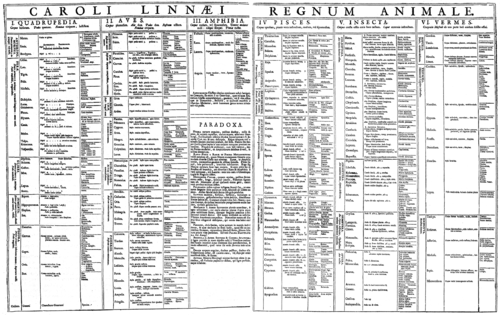1735 in science
Appearance
| |||
|---|---|---|---|
| +... |
| 1735 in science |
|---|
| Fields |
| Technology |
| Social sciences |
| Paleontology |
| Extraterrestrial environment |
| Terrestrial environment |
| Other/related |
The year 1735 in science and technology involved some significant events.
Astronomy
[edit]- July 11 - Pluto (not known at this time) enters a fourteen-year period inside the orbit of Neptune, which will not recur until 1979.

Biology
[edit]- Carl Linnaeus publishes his Systema Naturae.
Chemistry
[edit]- Cobalt is discovered and isolated by Georg Brandt.[1] This is the first metal discovered since ancient times.
Earth sciences
[edit]- May – French Geodesic Mission (including Charles Marie de La Condamine, Pierre Bouguer, Louis Godin, Jorge Juan, Antonio de Ulloa, Joseph de Jussieu and Jean Godin) sets out for Ecuador.[2]
Mathematics
[edit]- Leonhard Euler solves the Basel problem, first posed by Pietro Mengoli in 1644, and the Seven Bridges of Königsberg problem.
Meteorology
[edit]- May 22 – George Hadley publishes the first explanation of the trade winds.[3][4][5]
Physiology and medicine
[edit]- December 6 – The second successful appendectomy is performed by naturalised British surgeon Claudius Aymand at St George's Hospital in London (the first was in 1731).[6]
Births
[edit]- April 21 – Ivan Petrovich Kulibin, Russian inventor (died 1818)
- May 17 (bapt.) – John Brown, Scottish physician (died 1788)
- August 7 – Claudine Picardet, French, chemist, mineralogist, meteorologist and scientific translator (died 1820)
- September 6 – John Joseph Merlin, Liégeois-born inventor (died 1803)
- October 6 – Jesse Ramsden, English scientific instrument maker (died 1800)
- December 4 – Josephus Nicolaus Laurenti, Viennese herpetologist (died 1805)
Deaths
[edit]- February 27 – Dr John Arbuthnot, British polymath (born 1667)
- September 27 – Peter Artedi, Swedish naturalist (born 1705)
References
[edit]- ^ Reported by Brandt in Acta Literaria et Scientiarum Sveciae (Uppsala) and recalled by him in his Presidential address, "Tal on Färg Cobalter", to the Royal Swedish Academy of Sciences (Stockholm, 1860). Gusenius, Edwin M. (1967). "Beginnings of Greatness in Swedish Chemistry: Georg Brandt (1694–1768)". Transactions of the Kansas Academy of Science. 70: 413–425. doi:10.2307/3627593. JSTOR 3627593.
- ^ Ferreiro, Larrie (2011). Measure of the Earth: the Enlightenment Expedition that Reshaped our World. New York: Basic Books. ISBN 978-0-465-01723-2.
- ^ Philosophical Transactions of the Royal Society 39: 58–62.
- ^ McConnell, Anita (2004). "Hadley, George (1685–1768)". Oxford Dictionary of National Biography. Oxford University Press. doi:10.1093/ref:odnb/11858. Retrieved 2011-09-27. (subscription or UK public library membership required)
- ^ The Hutchinson Factfinder. Helicon. 1999. ISBN 1-85986-000-1.
- ^ Hutchinson, R. (February 1993). "Amyand's hernia". Journal of the Royal Society of Medicine. 86 (2): 104–105. PMC 1293861. PMID 8433290.
